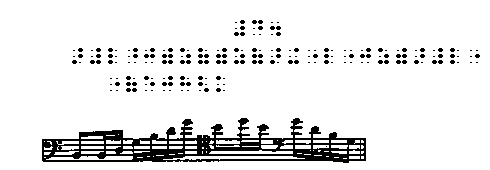|
(Table 2)
Signs from Table 2.
 |


 |
G clef; treble |
|


 |
G clef in the left hand part |
 |


 |
F clef; bass |
|


 |
F clef in the right hand part |
 |


 |
C clef; alto clef for viola or high clef for bass |
 |



 |
C clef on fourth line; tenor clef |
 |




 |
G clef with small 8 above |
|




 |
G clef with small 8 below |
2-1. Although clef signs do not determine pitches of notes in braille as they
do in print, a knowledge of clef signs is vital to a complete
understanding of print music. In print, a clef sign appears at the
beginning of every staff music. In braille, when clef signs are used,
they generally appear only at the beginning of pieces unless there is a
change of clef.
2-2. Some countries use clef signs with all braille music except keyboard
music. Others omit them for an instrument, such as violin, that always
plays in the same clef. When an instrument such as the cello changes
clefs, the clef sign information is important in teaching materials.
2-3. The note following a clef sign must have an octave mark.
2-4. Dot 3 must follow a clef sign if the next character contains dots 1, 2, or 3.
2-5. When a treble clef sign is printed in the bass staff or a bass clef sign is
printed in the treble staff, the forms above, 

 and and


 are especially useful to teachers of sighted students.
See Example 15-14. are especially useful to teachers of sighted students.
See Example 15-14.
Sign from Table 14
 Hyphen for unfinished measure Hyphen for unfinished measure
2-6. Clef signs can appear on any line of the staff. In order to show the line on
which the clef sign is placed, its final character, dots 1-2-3, is preceded
by an octave mark as follows:
Example 2-6.

2-7. A clef sign with a small 8 below indicates that the notes should sound
one octave lower than written. Similarly, a clef with an 8 above the
sign indicates that notes should sound one octave higher than written;
a 16 above or below a clef sign indicates that notes should sound two
octaves higher or lower. Example 2-7 is music for lute. The clef sign
indicates that the notes will sond one octave lower, but the pitches
are transcribed as printed.
Example 2-7.

|